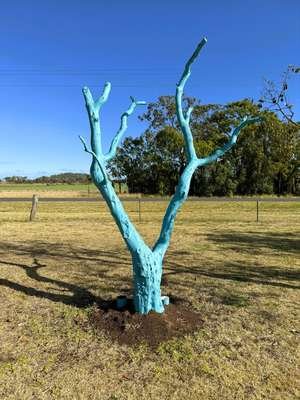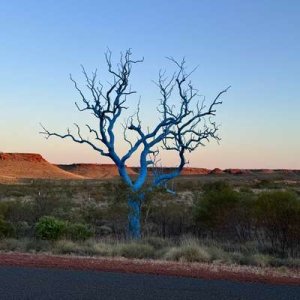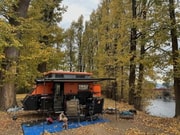Why are trees turning blue all over the country? The reason behind this trend will surprise you
By
Maan
- Replies 4
Sometimes, the most eye-catching sights have a deeper story behind them.
What may seem like just a strange trend or a passing moment can carry a powerful message that’s worth exploring.
Keep reading to find out why this phenomenon has captured the attention of so many.
Blue trees started appearing across the country, with over a thousand now showing their bright, unexpected colour.
Many Australians who spotted these striking trees were left wondering about their significance.
A Canberra woman shared her experience in a social media group for bird enthusiasts: 'We were driving one afternoon when we spotted a blue tree.'
Curious, she searched online to understand why they existed, only to be met with what she described as 'overwhelming' negativity from others in the group.
Critics voiced strong opinions, including comments like, 'The blue tree stuff is nonsense, it's environmental vandalism...Completely ruins the natural beauty of an area too. A ridiculous trend,'
Another chimed in: 'It completely screws the ability for insects to use and camouflage on the wood.'
Despite the pushback, the woman soon learned that the blue trees were part of an initiative by an Australian charity aimed at promoting mental health awareness.
The Blue Tree Project, founded by Kendall Whyte, had been established a year after she lost her brother to suicide in 2018.
'Like many initiatives there will always be people who don't connect with our cause and mission,' Kendall shared. 'However, the support over the last six years has been overwhelmingly positive.'
The blue tree project focused exclusively on dead trees, known as stags, and is now featured in every continent of the world.
'There is now a blue tree on every continent of the world – making us a global movement,' Kendall said.
The project's origins were deeply personal, stemming from a practical joke Kendall's brother had played on their family.
He had once painted a tree on their West Australian property to surprise their father, and the idea became the symbol of an important movement.
With suicide being the leading cause of death for Australians aged 15-49, the Blue Tree Project aimed to break the stigma around mental health.
Kendall noted that outdated attitudes were still embedded in the country, making it difficult for many to seek the help they needed.
'Education is crucial, not only in shifting old attitudes, but also up-skilling ourselves to have the harder and more confronting conversations in life,' she stated.
The organisation's work extended beyond painting trees; it included workshops with corporate partners designed to support Australians in navigating mental health conversations and creating a culture of empathy and awareness.
As the festive season approached, locals were reminded that Christmas could be a particularly hard time for those grappling with mental health struggles.
Professor Ian Hickie, Co-Director of the Brain and Mind Centre at the University of Sydney, pointed out that the holiday period posed unique challenges.
'Particularly those who are struggling, or who are isolated, or are in conflict with their family and others, it's often a really difficult time,' Professor Hickie said.
'The health care system goes on holiday and many of the people who provide them with support, those services, are reduced to emergency services.'
He emphasised that during this period, many people who needed assistance faced even greater difficulties as support systems were limited.
Kendall also stressed the importance of being mindful of overall well-being
'Often we don't realise how important our overall well-being is, until it's too late, and significant support is needed to get back on track,' she said.
In this season of cheer, we’re encouraged to reach out to friends and loved ones. The blue trees, now scattered across the landscape and the world, stand as a poignant reminder of the ongoing need for conversations that could save lives.

Have you seen a blue tree in your area, or do you have thoughts on the project? Share your perspective in the comments below—let’s keep the conversation going.
What may seem like just a strange trend or a passing moment can carry a powerful message that’s worth exploring.
Keep reading to find out why this phenomenon has captured the attention of so many.
Blue trees started appearing across the country, with over a thousand now showing their bright, unexpected colour.
Many Australians who spotted these striking trees were left wondering about their significance.
A Canberra woman shared her experience in a social media group for bird enthusiasts: 'We were driving one afternoon when we spotted a blue tree.'
Curious, she searched online to understand why they existed, only to be met with what she described as 'overwhelming' negativity from others in the group.
Critics voiced strong opinions, including comments like, 'The blue tree stuff is nonsense, it's environmental vandalism...Completely ruins the natural beauty of an area too. A ridiculous trend,'
Another chimed in: 'It completely screws the ability for insects to use and camouflage on the wood.'
Despite the pushback, the woman soon learned that the blue trees were part of an initiative by an Australian charity aimed at promoting mental health awareness.
The Blue Tree Project, founded by Kendall Whyte, had been established a year after she lost her brother to suicide in 2018.
'Like many initiatives there will always be people who don't connect with our cause and mission,' Kendall shared. 'However, the support over the last six years has been overwhelmingly positive.'
The blue tree project focused exclusively on dead trees, known as stags, and is now featured in every continent of the world.
'There is now a blue tree on every continent of the world – making us a global movement,' Kendall said.
The project's origins were deeply personal, stemming from a practical joke Kendall's brother had played on their family.
He had once painted a tree on their West Australian property to surprise their father, and the idea became the symbol of an important movement.
With suicide being the leading cause of death for Australians aged 15-49, the Blue Tree Project aimed to break the stigma around mental health.
Kendall noted that outdated attitudes were still embedded in the country, making it difficult for many to seek the help they needed.
'Education is crucial, not only in shifting old attitudes, but also up-skilling ourselves to have the harder and more confronting conversations in life,' she stated.
The organisation's work extended beyond painting trees; it included workshops with corporate partners designed to support Australians in navigating mental health conversations and creating a culture of empathy and awareness.
As the festive season approached, locals were reminded that Christmas could be a particularly hard time for those grappling with mental health struggles.
Professor Ian Hickie, Co-Director of the Brain and Mind Centre at the University of Sydney, pointed out that the holiday period posed unique challenges.
'Particularly those who are struggling, or who are isolated, or are in conflict with their family and others, it's often a really difficult time,' Professor Hickie said.
'The health care system goes on holiday and many of the people who provide them with support, those services, are reduced to emergency services.'
He emphasised that during this period, many people who needed assistance faced even greater difficulties as support systems were limited.
Kendall also stressed the importance of being mindful of overall well-being
'Often we don't realise how important our overall well-being is, until it's too late, and significant support is needed to get back on track,' she said.
In this season of cheer, we’re encouraged to reach out to friends and loved ones. The blue trees, now scattered across the landscape and the world, stand as a poignant reminder of the ongoing need for conversations that could save lives.
Key Takeaways
- Blue trees have been appearing across the country, with over a thousand now painted in bright blue.
- The Blue Tree Project was founded to raise awareness and challenge the stigma around mental health.
- Suicide is the leading cause of death for Australians aged 15-49, highlighting the need for open conversations.
- The initiative aims to encourage conversations and promote support for mental health issues.
Have you seen a blue tree in your area, or do you have thoughts on the project? Share your perspective in the comments below—let’s keep the conversation going.









